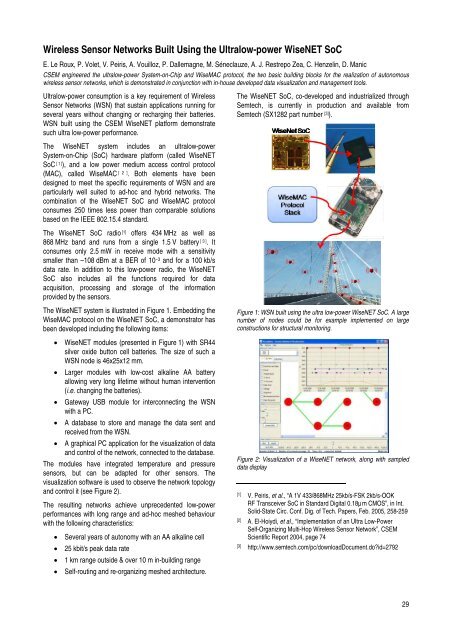CSEM Scientific and Technical Report 2008
CSEM Scientific and Technical Report 2008
CSEM Scientific and Technical Report 2008
You also want an ePaper? Increase the reach of your titles
YUMPU automatically turns print PDFs into web optimized ePapers that Google loves.
Wireless Sensor Networks Built Using the Ultralow-power WiseNET SoC<br />
E. Le Roux, P. Volet, V. Peiris, A. Vouilloz, P. Dallemagne, M. Séneclauze, A. J. Restrepo Zea, C. Henzelin, D. Manic<br />
<strong>CSEM</strong> engineered the ultralow-power System-on-Chip <strong>and</strong> WiseMAC protocol, the two basic building blocks for the realization of autonomous<br />
wireless sensor networks, which is demonstrated in conjunction with in-house developed data visualization <strong>and</strong> management tools.<br />
Ultralow-power consumption is a key requirement of Wireless<br />
Sensor Networks (WSN) that sustain applications running for<br />
several years without changing or recharging their batteries.<br />
WSN built using the <strong>CSEM</strong> WiseNET platform demonstrate<br />
such ultra low-power performance.<br />
The WiseNET system includes an ultralow-power<br />
System-on-Chip (SoC) hardware platform (called WiseNET<br />
SoC [ 1] ), <strong>and</strong> a low power medium access control protocol<br />
(MAC), called WiseMAC [ 2 ] . Both elements have been<br />
designed to meet the specific requirements of WSN <strong>and</strong> are<br />
particularly well suited to ad-hoc <strong>and</strong> hybrid networks. The<br />
combination of the WiseNET SoC <strong>and</strong> WiseMAC protocol<br />
consumes 250 times less power than comparable solutions<br />
based on the IEEE 802.15.4 st<strong>and</strong>ard.<br />
The WiseNET SoC radio [1] offers 434 MHz as well as<br />
868 MHz b<strong>and</strong> <strong>and</strong> runs from a single 1.5 V battery [ 3] . It<br />
consumes only 2.5 mW in receive mode with a sensitivity<br />
smaller than –108 dBm at a BER of 10 −3 <strong>and</strong> for a 100 kb/s<br />
data rate. In addition to this low-power radio, the WiseNET<br />
SoC also includes all the functions required for data<br />
acquisition, processing <strong>and</strong> storage of the information<br />
provided by the sensors.<br />
The WiseNET system is illustrated in Figure 1. Embedding the<br />
WiseMAC protocol on the WiseNET SoC, a demonstrator has<br />
been developed including the following items:<br />
• WiseNET modules (presented in Figure 1) with SR44<br />
silver oxide button cell batteries. The size of such a<br />
WSN node is 46x25x12 mm.<br />
• Larger modules with low-cost alkaline AA battery<br />
allowing very long lifetime without human intervention<br />
(i.e. changing the batteries).<br />
• Gateway USB module for interconnecting the WSN<br />
with a PC.<br />
• A database to store <strong>and</strong> manage the data sent <strong>and</strong><br />
received from the WSN.<br />
• A graphical PC application for the visualization of data<br />
<strong>and</strong> control of the network, connected to the database.<br />
The modules have integrated temperature <strong>and</strong> pressure<br />
sensors, but can be adapted for other sensors. The<br />
visualization software is used to observe the network topology<br />
<strong>and</strong> control it (see Figure 2).<br />
The resulting networks achieve unprecedented low-power<br />
performances with long range <strong>and</strong> ad-hoc meshed behaviour<br />
with the following characteristics:<br />
• Several years of autonomy with an AA alkaline cell<br />
• 25 kbit/s peak data rate<br />
• 1 km range outside & over 10 m in-building range<br />
• Self-routing <strong>and</strong> re-organizing meshed architecture.<br />
The WiseNET SoC, co-developed <strong>and</strong> industrialized through<br />
Semtech, is currently in production <strong>and</strong> available from<br />
Semtech (SX1282 part number [3] ).<br />
Figure 1: WSN built using the ultra low-power WiseNET SoC. A large<br />
number of nodes could be for example implemented on large<br />
constructions for structural monitoring.<br />
Figure 2: Visualization of a WiseNET network, along with sampled<br />
data display<br />
[1] V. Peiris, et al., “A 1V 433/868MHz 25kb/s-FSK 2kb/s-OOK<br />
RF Transceiver SoC in St<strong>and</strong>ard Digital 0.18µm CMOS”, in Int.<br />
Solid-State Circ. Conf. Dig. of Tech. Papers, Feb. 2005, 258-259<br />
[2] A. El-Hoiydi, et al., “Implementation of an Ultra Low-Power<br />
Self-Organizing Multi-Hop Wireless Sensor Network”, <strong>CSEM</strong><br />
<strong>Scientific</strong> <strong>Report</strong> 2004, page 74<br />
[3] http://www.semtech.com/pc/downloadDocument.do?id=2792<br />
29








